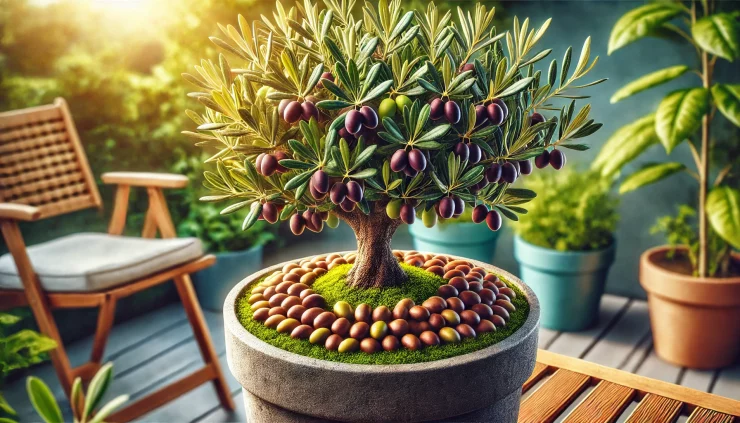Growing an olive tree from seed at home is a rewarding and enjoyable process that allows you to cultivate a beautiful, productive plant. While olive trees can take several years to mature and produce fruit, the journey of growing them from seed can be a fascinating experience. Here’s a step-by-step guide to help you successfully grow an olive tree in containers.
Materials Needed
Olive seeds (from a ripe, pesticide-free olive)
Small containers (for germination)
Large containers (for transplanting)
Potting soil
Sand or perlite (for drainage)
Plastic wrap or a humidity dome
Watering can
Fertilizer (balanced, slow-release)
Step-by-Step Guide
1.Selecting and Preparing the Seeds
Choose Ripe Olives: Select ripe, organic olives that are free from pesticides. Avoid using store-bought olives that are processed or preserved.
Extract the Seeds: Carefully remove the seeds (pits) from the olives. Wash the seeds thoroughly to remove any remaining fruit residue.
Scarification: Lightly scratch the surface of the seeds with sandpaper to help with water absorption and germination.
2.Germinating the Seeds
Soak the Seeds: Place the seeds in a bowl of warm water and let them soak for 24-48 hours. This helps to soften the seed coat and initiate the germination process.
Prepare the Germination Containers: Fill small containers with a mix of potting soil and sand or perlite for improved drainage. Moisten the soil lightly.
Plant the Seeds: Plant the seeds about 1 inch deep in the soil. Cover the containers with plastic wrap or a humidity dome to retain moisture and warmth.
Provide Warmth and Light: Place the containers in a warm location with indirect sunlight. Ideal temperatures for germination are between 70-75°F (21-24°C).
3.Caring for Germinating Seeds
Maintain Moisture: Keep the soil consistently moist but not waterlogged. Check daily and water as needed.
Ventilation: Remove the plastic wrap or humidity dome periodically to allow air circulation and prevent mold growth.
Patience: Germination can take several weeks to a few months. Be patient and continue to care for the seeds during this time.
4.Transplanting Seedlings
Select Larger Containers: Once the seedlings have developed a few sets of true leaves, they are ready to be transplanted into larger containers. Choose containers that are at least 12 inches in diameter with drainage holes.
Prepare the Soil: Use a well-draining potting mix with added sand or perlite. Olive trees prefer slightly alkaline soil, so you can add a bit of lime if necessary.
Transplant Carefully: Gently remove the seedlings from the germination containers, being careful not to damage the roots. Plant them in the larger containers at the same depth they were growing before.
5.Caring for Olive Trees in Containers
Sunlight: Olive trees require at least 6-8 hours of direct sunlight daily. Place the containers in a sunny spot, such as a south-facing window or a balcony.
Watering: Water the olive trees regularly, allowing the soil to dry out slightly between waterings. Overwatering can lead to root rot.
Fertilizing: Use a balanced, slow-release fertilizer during the growing season (spring and summer). Follow the instructions on the fertilizer package for the appropriate dosage.
Pruning: Prune the olive tree to maintain its shape and remove any dead or diseased branches. Pruning also encourages healthy growth and better air circulation.
Winter Care: Olive trees are sensitive to frost. If you live in a region with cold winters, bring the containers indoors or provide protection such as wrapping the containers with insulating material.
Growing an olive tree from seed at home in containers is a fulfilling project that allows you to witness the growth and development of a beautiful and productive plant. By following these steps and providing the right care, you can successfully cultivate an olive tree that will thrive in your home. Enjoy the journey of growing your olive tree and look forward to the day it bears fruit!






Add comment